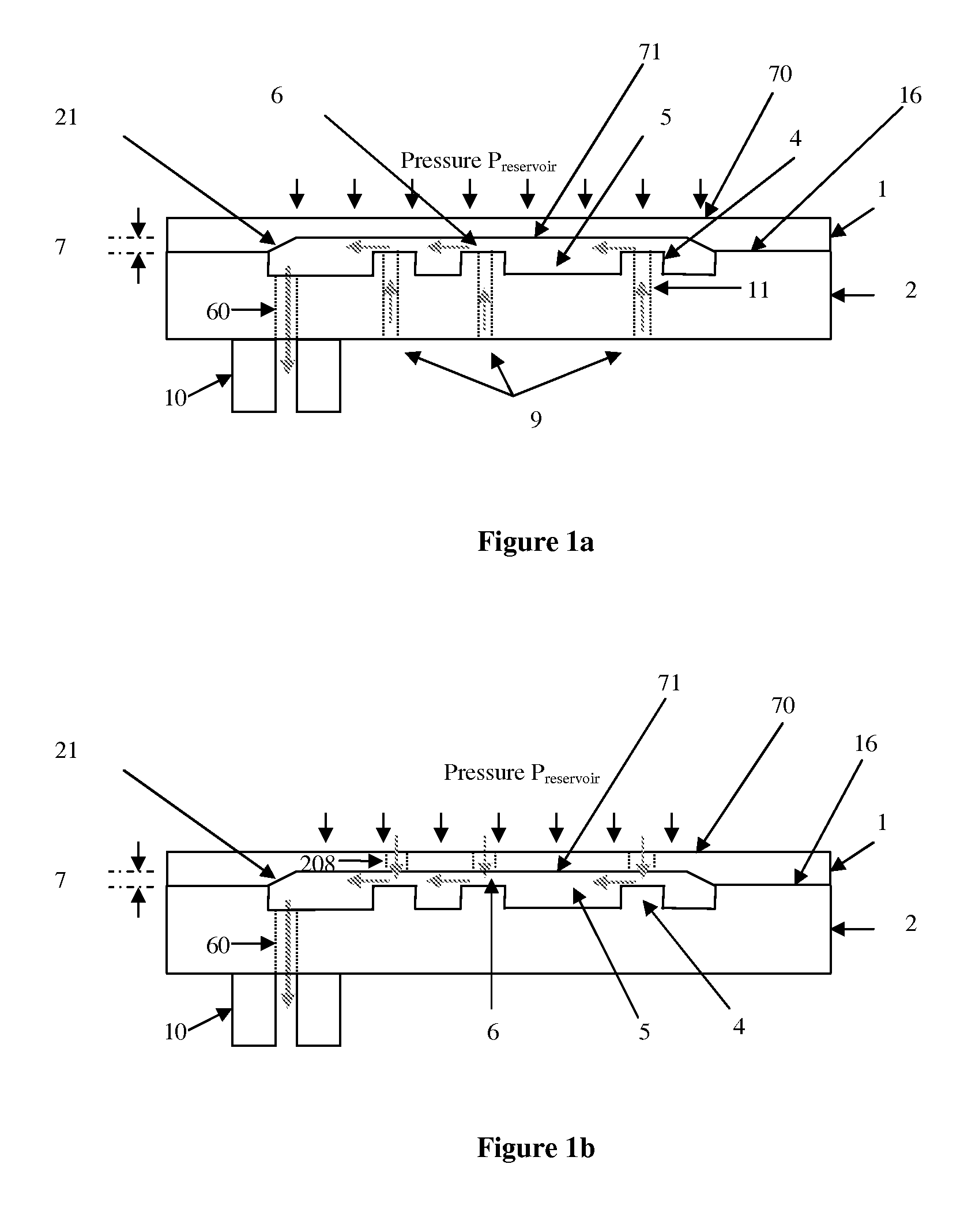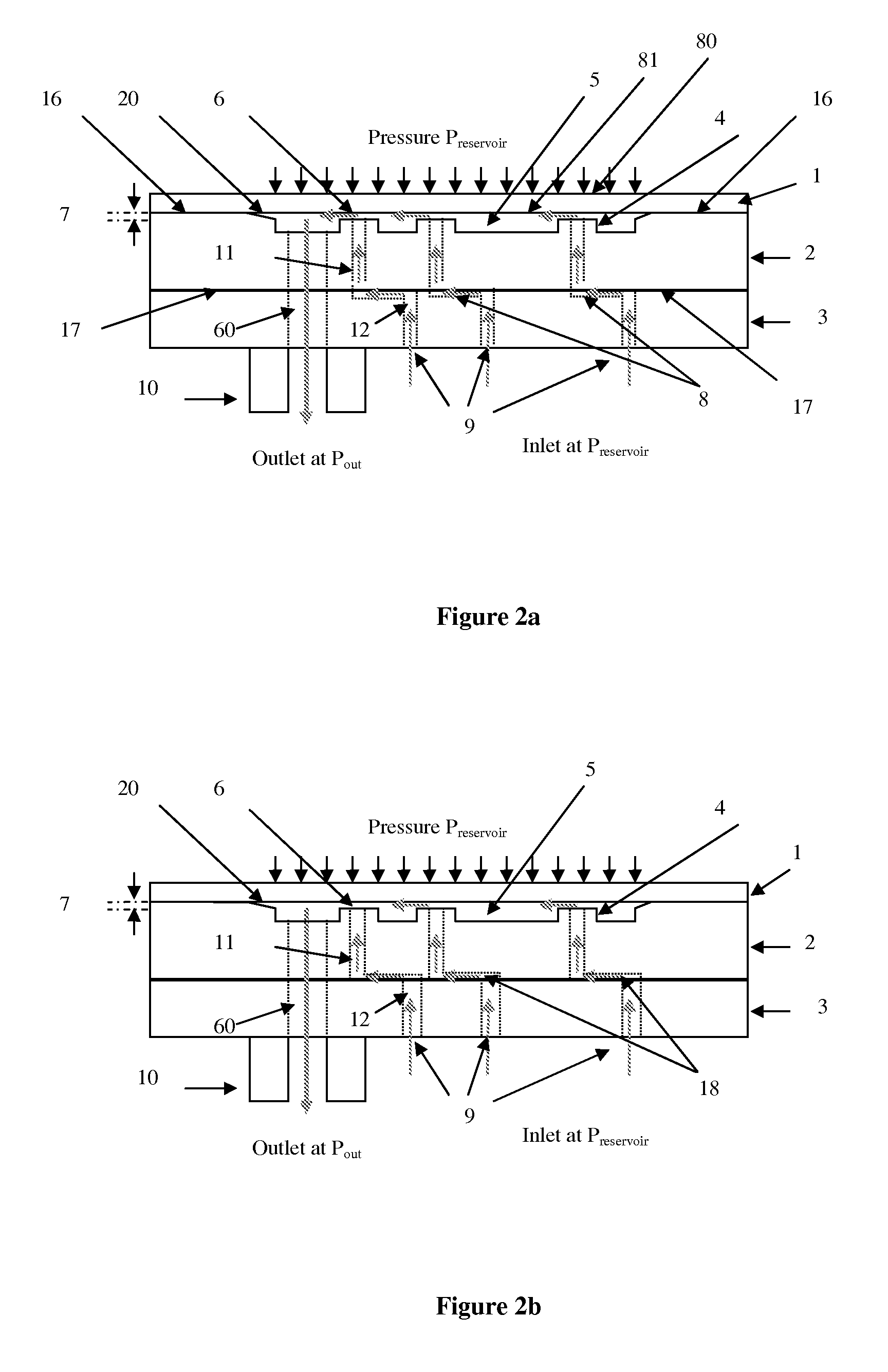Micromechanic passive flow regulator
a passive flow regulator and micromechanic technology, applied in the direction of flow monitors, wound drains, medical devices, etc., can solve the problems of complicated and expensive fabrication of such devices, affecting the accuracy level, and affecting the flow of fluid through, so as to achieve easy and cheaper manufacturing, the effect of more flexibility and accuracy
- Summary
- Abstract
- Description
- Claims
- Application Information
AI Technical Summary
Benefits of technology
Problems solved by technology
Method used
Image
Examples
first embodiment
[0058]FIG. 15a shows a simplified plan view of the present invention with additional protective top cap and a fluidic switch in position 1 wherein the pressure is transmitted from the reservoir to only the inlet of the device.
[0059]FIG. 15b shows a simplified plan view of the first embodiment of the present invention with additional protective top cap and a fluidic switch in position 2 wherein the pressure is transmitted from the reservoir to both device inlet and protective cap cavity.
[0060]FIG. 16 shows the simulated flow rate versus pressure characteristic of a passive flow regulator having a silicon membrane according to the dimensions given in table 1.
[0061]FIG. 17 shows the simulated flow rate versus pressure characteristic of a passive flow regulator having a silicon membrane according to the dimensions given in table 2.
[0062]FIG. 18 shows the simulated flow rate versus pressure characteristic of a passive flow regulator having a PMMA membrane according to the dimensions give...
third embodiment
[0128]FIG. 4a shows a first simplified view of flow regulator based on a SOI pillar plate 31.
[0129]Depending on the process yield, all the critical parts may be included into the pillar plate 36 as shown FIG. 4b (e.g. SOI design shown hereafter with the recess 20 etched in the pillar plate 36). The membrane 1 is a simple flat plate without any machining while the bottom plates 3 is another simple flat plate only drilled in order to make the inlet through holes 12. The outlet port 10 could be a connector attached by any means including gluing to the bottom plate 3.
[0130]FIG. 4c shows a third simplified view of the third embodiment of the present invention, wherein both membrane 38 and pillar plates 36 are machined to create the gap 7.
[0131]The pillar plate 37 may also contain no critical part as shown in FIG. 4d. The channel may be obtained by using again by using an SOI wafer for the bottom plate 39.
[0132]In another embodiment the device is only made of two plates, the membrane 1 an...
fifth embodiment
[0151]A simplified pillar plate front view of one of the fifth embodiment is shown FIG. 9a.
[0152]The membrane back-side (etched side) of this another embodiment is shown FIG. 9b. Depending on the process used, the recess 104 or 105 may have a recess wall showing a slope. By using anisotropic wet etch on silicon wafer, the typical recess wall angle is 54.7°.
[0153]The different cavities in the device should be interconnected as shown FIG. 9a with the openings 120. Ideally, the fluidic resistances of these interconnections are designed to ensure that the pressure in all cavities is very close to the outlet pressure.
[0154]The membrane plate 100 can include membranes of any shape including squared, rectangular, elliptical and circular membrane. Membrane of different shapes can be made in the same membrane plate 100.
[0155]In the two preferred embodiments of the present invention, the deformation of the membrane 1 against a pillar plate 2 is used. This effect is strongly non-linear, resu...
PUM
 Login to View More
Login to View More Abstract
Description
Claims
Application Information
 Login to View More
Login to View More - R&D
- Intellectual Property
- Life Sciences
- Materials
- Tech Scout
- Unparalleled Data Quality
- Higher Quality Content
- 60% Fewer Hallucinations
Browse by: Latest US Patents, China's latest patents, Technical Efficacy Thesaurus, Application Domain, Technology Topic, Popular Technical Reports.
© 2025 PatSnap. All rights reserved.Legal|Privacy policy|Modern Slavery Act Transparency Statement|Sitemap|About US| Contact US: help@patsnap.com



